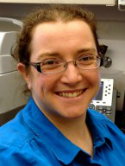Hereditary leiomyomatosis and renal cell carcinoma syndrome-associated renal cancer: Recognition of the syndrome by pathologic features and the utility of detecting aberrant succination by immunohistochemistry Journal Article
| Authors: | Chen, Y. B.; Brannon, A. R.; Toubaji, A.; Dudas, M. E.; Won, H. H.; Al-Ahmadie, H. A.; Fine, S. W.; Gopalan, A.; Frizzell, N.; Voss, M. H.; Russo, P.; Berger, M. F.; Tickoo, S. K.; Reuter, V. E. |
| Article Title: | Hereditary leiomyomatosis and renal cell carcinoma syndrome-associated renal cancer: Recognition of the syndrome by pathologic features and the utility of detecting aberrant succination by immunohistochemistry |
| Abstract: | Hereditary leiomyomatosis and renal cell carcinoma (HLRCC) syndrome is an autosomal dominant disorder in which germline mutations of fumarate hydratase (FH) gene confer an increased risk of cutaneous and uterine leiomyomas and renal cancer. HLRCC-associated renal cancer is highly aggressive and frequently presents as a solitary mass. We reviewed the clinicopathologic features of 9 patients with renal tumors presenting as sporadic cases but who were later proven to have FH germline mutations. Histologically, all tumors showed mixed architectural patterns, with papillary as the dominant pattern in only 3 cases. Besides papillary, tubular, tubulopapillary, solid, and cystic elements, 6 of 9 tumors contained collecting duct carcinoma-like areas with infiltrating tubules, nests, or individual cells surrounded by desmoplastic stroma. Prominent tubulocystic carcinoma-like component and sarcomatoid differentiation were identified. Although all tumors exhibited the proposed hallmark of HLRCC (large eosinophilic nucleolus surrounded by a clear halo), this feature was often not uniformly present throughout the tumor. Prior studies have shown that a high level of fumarate accumulated in HLRCC tumor cells causes aberrant succination of cellular proteins by forming a stable chemical modification, S-(2-succino)-cysteine (2SC), which can be detected by immunohistochemistry. We thus explored the utility of detecting 2SC by immunohistochemistry in the differential diagnosis of HLRCC tumors and other high-grade renal tumors and investigated the correlation between 2SC staining and FH molecular alterations. All confirmed HLRCC tumors demonstrated diffuse and strong nuclear and cytoplasmic 2SC staining, whereas all clear cell (184/184, 100%), most high-grade unclassified (93/97, 96%), and the large majority of "type 2" papillary (35/45, 78%) renal cell carcinoma cases showed no 2SC immunoreactivity. A subset of papillary (22%) and rare unclassified (4%) tumors showed patchy or diffuse cytoplasmic staining without nuclear labeling, unlike the pattern seen with confirmed HLRCC tumors. Sequencing revealed no germline or somatic FH alterations in 14 tumors that either exhibited only cytoplasmic 2SC staining (n=5) or were negative for 2SC (n=9), despite their HLRCC-like morphologic features. Our results emphasize the pivotal role of pathologic examination in the diagnosis of HLRCC patients and indicate immunohistochemical detection of 2SC as a useful ancillary tool in the differentiation of HLRCC renal tumors from other high-grade renal cell carcinomas. © 2014 by Lippincott Williams and Wilkins. |
| Keywords: | immunohistochemistry; fumarate hydratase; renal cancer; hlrcc; 2sc; succination |
| Journal Title: | American Journal of Surgical Pathology |
| Volume: | 38 |
| Issue: | 5 |
| ISSN: | 0147-5185 |
| Publisher: | Lippincott Williams & Wilkins |
| Date Published: | 2014-05-01 |
| Start Page: | 627 |
| End Page: | 637 |
| Language: | English |
| DOI: | 10.1097/pas.0000000000000163 |
| PROVIDER: | scopus |
| PMCID: | PMC3984629 |
| PUBMED: | 24441663 |
| DOI/URL: | |
| Notes: | Am. J. Surg. Pathol. -- Export Date: 2 June 2014 -- CODEN: AJSPD -- Source: Scopus |
Altmetric
Citation Impact
BMJ Impact Analytics
MSK Authors
Related MSK Work















